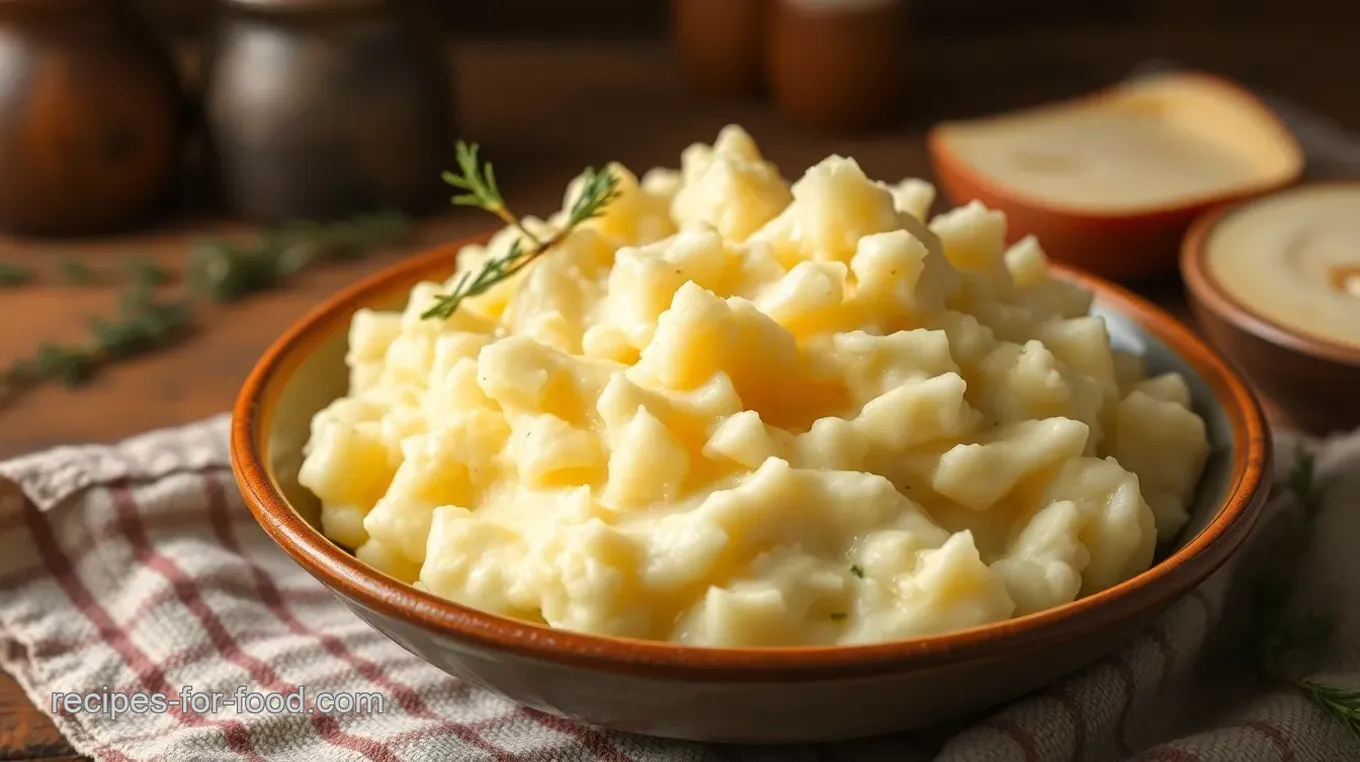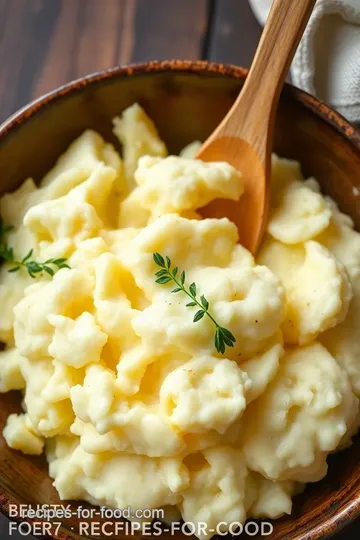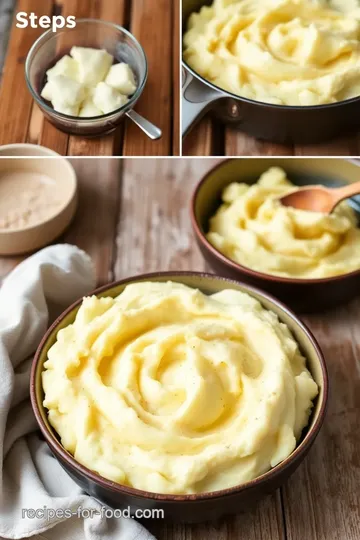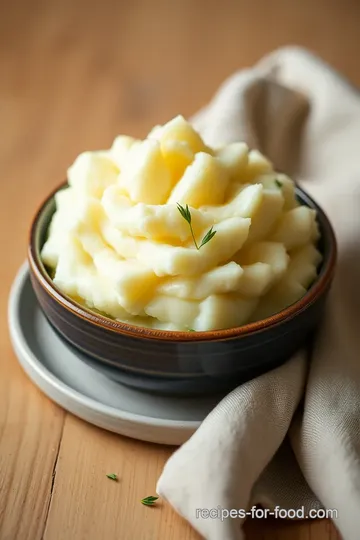Ultimate Creamy and Fluffy Boiled Mashed Potatoes
Craving the best Boiled Mashed Potatoes: Creamy and Fluffy? Discover my easy recipe with buttery goodness for a cozy side dish that shines at every meal!

- Finding Comfort in Every Bite
- The Heart of the Recipe
- Why You’ll Love It
- A Dish for Every Occasion
- Essential Ingredients Guide: Making Ultimate Creamy and Fluffy Boiled Mashed Potatoes
- Mastering the Art of Boiling and Mashing Potatoes
- Pro Tips & Secrets for the Ultimate Creamy and Fluffy Boiled Mashed Potatoes
- Perfect Presentation
- Storage & Make-Ahead
- Creative Variations
- Complete Nutrition Guide
- Encouraging Conclusion
- Frequently Asked Questions
- Recipe Card
Finding Comfort in Every Bite
You know that feeling when you sink your fork into a plate of boiled mashed potatoes: creamy and fluffy ? oh my gosh, it’s like a warm hug from the inside! it takes me back to family gatherings where we’d crowd around the table, laughing and sharing stories, all while relishing this ultimate comfort food.
Isn’t it funny how food can stir up so many memories? i mean, who doesn’t love a good buttery potato? if you’re looking to impress friends or just treat yourself, this simple potato recipe is what you need in your life.
The Heart of the Recipe
Mashed potatoes have been a staple in kitchens for centuries, believed to have soared in popularity in the 18th century.
They’ve evolved over the years, but the heart of this homemade mashed potatoes recipe remains pure and simple— potatoes, butter, and cream.
Today, they’re a must-have at family dinners, holiday feasts, and even casual weeknights. honestly, they’re one of those potato sides that pairs beautifully with just about anything, from meatloaf to a rich veggie stew.
Don’t worry if you’re not a culinary whiz; this recipe is straightforward and totally doable. with just 15 minutes of prep and 20 minutes of cooking , you can whip up a dish that serves four people without breaking a sweat.
Plus, it won’t empty your wallet!
Why You’ll Love It
Okay, let’s talk benefits. first and foremost, creamy mashed potatoes are packed with starches , which mean they’ve got energy for days! plus, potatoes are a great source of vitamin c and potassium, so you can feel good about indulging a bit.
And let's not forget how comforting a bowl of fluffy mashed potatoes can be, perfect for cuddling up on a chilly night or serving up at festive gatherings.
But that’s not all! the beauty of this dish is in its versatility. want to bring a bit of flair? you can infuse those potatoes with garlic, add cheese, or even whip in some herbs.
The variations are endless! you can even keep it trendy and make dairy-free mashed potatoes using coconut milk or cashew cream.
A Dish for Every Occasion
Looking to impress at your next dinner party? these smooth mashed potatoes will definitely do the trick. dress them up with some mashed potato seasoning or drizzle on some gravy for that extra touch.
They’re also fantastic as side dishes for meat, pairing wonderfully with roasted chicken or pork chops. trust me, everyone will be going back for seconds—you may even have a few requests for the recipe!
It’s all about making that ultimate comfort food shine; serve them up with confidence. No stress, just deliciousness!
Now that you're excited to dive into this recipe let’s jump into the ingredients. You might have most of them sitting in your kitchen right now! Ready? Let’s go!

Essential Ingredients Guide: Making Ultimate Creamy and Fluffy Boiled Mashed Potatoes
Let’s dive into the world of ultimate creamy and fluffy boiled mashed potatoes , shall we? if you’ve ever faced the holiday dinner table or just a cozy weeknight meal, you know that mashed potatoes are the ultimate comfort food recipe.
But let's get down to the nitty-gritty with some essential tips and ingredients you'll need to nail that classic mashed potato experience.
Premium Core Components
When it comes to crafting those heavenly potatoes, think about your foundation. you’ll need 2 pounds (900g) of yukon gold or russet potatoes , peeled and cut into 1-inch chunks.
Why choose these? they’re starchy enough to whip up smooth mashed potatoes without making the texture gummy.
Remember to sprinkle in 1 teaspoon (5g) of salt while boiling. Salt is your magic ingredient—it enhances flavor and pulls moisture from the potatoes, so don’t skimp on this step!
Storage? oh, it's easy! keep your potatoes in a cool, dark place. they’ll hang out for a couple of weeks.
But once mashed, enjoy them fresh or store leftovers in an airtight container in the fridge for up to 3 days .
Want to keep that freshness lasting longer? here’s a pro tip: if you're unsure about choosing the right potatoes, pick those that feel firm and have no sprouts.
You want to experience freshness at its best!
Signature Seasoning Blend
Okay, so we’ve got our potatoes. now for the flavor! to make those creamy potato sides sing, we’ll bring in some delicious partners.
A popular combo is 4 tablespoons (55g) of unsalted butter and ½ cup (120ml) of heavy cream (or whole milk) .
For something extra, toss in a little ¼ cup (30g) sour cream or cream cheese to crank up the creaminess.
But let’s not stop there! you can infuse herbs to create your own herb-infused mashed potatoes . think chives or even roasted garlic—yum! and hey, if you're feeling experimental, try flavored butters or gravies to add that wow factor.
Smart Substitutions
Sometimes, life doesn’t give us what we planned. so what if you’re short on some ingredients? no worries! if you don’t have heavy cream, you can definitely use half-and-half or even whole milk.
And for my vegan friends, swapping dairy out for almond milk or coconut cream can totally work, making your own delicious dairy-free mashed potatoes .
If you’re ever in a pinch for butter, olive oil can be your best buddy. you'd be surprised how tasty potatoes with olive oil can get.
Plus, let’s chat about seasonal options —how about adding in some roasted butternut squash in the fall?
Kitchen Equipment Essentials
Don't forget your tools! a good setup makes all the difference. grab a big pot for boiling, a potato masher or ricer for that fluffy finish, and, of course, a colander for draining those tender spuds.
Each tool plays a role in making sure your creamy potato side dish is perfect.
Preparation tips? Just a few: Always rinse your potatoes before cooking. It helps remove excess starch that can turn your dreams of fluffy mashed potatoes into a gummy reality.
And here’s the kicker: let your potatoes steam in the colander after boiling for a few minutes to get rid of any leftover moisture.
Think of this step as a spa day for your potatoes—they’ll come out silky and dreamy.
A Final Thought
As we gather the essentials for our ultimate creamy and fluffy boiled mashed potatoes , remember—it's in the details. quality ingredients, thoughtful pairings, and the right techniques will elevate your dish from good to unforgettable.
So whether it's for a casual tuesday night or a grand feast, these mad spuds are set to impress.
Now that we've got the scoop on ingredients, let’s jump into the step-by-step instructions to whip up this deliciousness! get ready to enjoy the best warm potato dish that will leave you (and your guests) smiling with every bite.
🍽️

Mastering the Art of Boiling and Mashing Potatoes
I’m just gonna say it: boiled mashed potatoes are a staple for good reason! they’re warm, cozy, and a total comfort food.
Who doesn’t love sinking a fork into some creamy, fluffy goodness? buckle up, folks, because i'm about to walk you through making boiled mashed potatoes: creamy and fluffy —the ultimate side dish that complements almost any meal out there!
Essential Preparation Steps
First off, let's chat about mise en place . yeah, it sounds fancy, but it just means getting your ingredients ready.
So, peel 2 pounds of yukon gold or russet potatoes and cut them into 1-inch chunks . rinse them with cold water to wash away some of that starchy mess.
Trust me, soggy potatoes are not the vibe.
Next up is time management , which can make or break your cooking experience. once your potatoes are ready, set a timer for 15- 20 minutes .
That’s about how long they need to simmer until they’re fork-tender. multitasking is your friend here—while the potatoes boil, prep your butter and cream so they’re ready when it’s time to mash .
Now, let’s talk organization. make sure your kitchen is clutter-free. have your masher or ricer at the ready and keep a large pot on hand.
Honestly, i’ve been guilty of starting with a messy kitchen, and it only makes things more chaotic.
And, oh, safety first! Always be careful with boiling water. Your kitchen is your kingdom, but hot splashes can still catch you off guard. Keep a clean towel handy for spills.
Step-by-Step Process
Ready to roll? Here’s your step-by-step breakdown:
-
Place those prepared potatoes in a large pot. Cover them with cold water and throw in 1 teaspoon of salt . Bring the pot to a boil over high heat.
-
Once it boils, reduce the heat to medium and let them simmer for about 15- 20 minutes . You’re looking for that tender, fork-friendly texture.
-
Drain your potatoes and let them steam for 2- 3 minutes in the colander. This step is crucial—extra moisture means sad, gooey mashed potatoes, and nobody wants that.
-
While your potatoes are cooling a bit, heat ½ cup of cream and 4 tablespoons of butter in a small saucepan until the butter melts.
It should be warm, not scalding hot—try around 110° f .
-
Mash those potatoes back in the pot until they’re smooth , but don’t overdo it! A gentle touch goes a long way for that perfect potato texture.
-
Gradually mix in your creamy goodness. Add salt and pepper to taste , and listen to the world around you—this is when the smell kicks in!
-
Serve your creamy potato side dish warm. So simple, yet so satisfying.
Expert Techniques
Alright, let’s get a little deeper. Here are some pro tips to amp up your potato game.
-
Potato selection is everything. Yukon Golds will give you the best creamy texture, while Russets are a little fluffier. Choose based on your preference!
-
For smooth mashed potatoes , avoid over-mashing. I learned this the hard way the first time—no one wants gummy potatoes! Just mash until nice and creamy, and stop right there.
-
To mix in some extra flavors—garlic or herbs—warm that cream with them. it’ll give your mashed potatoes a unique twist! thinking of going dairy-free ? you can use coconut milk instead; it rocks.
Success Strategies
Here's the lowdown on avoiding common pitfalls.
-
Don’t rush the boiling process. The key to these classic mashed potatoes is in the timing.
-
Make-ahead? Totally! You can prepare the potatoes a day in advance and reheat them in the oven. Just add a splash of cream when you warm them back up.
-
For the perfect finish, try adding in some grated cheese for extra goodness. I personally love mashed potatoes with cheese —an instant upgrade!
And remember, keep an eye out for those quality checkpoints. Your mash should be smooth and velvety… so check it a couple of times as you mix in the goods.
If you do stray into trouble, mashed potato variations are endless. don’t hesitate to experiment with seasonings like garlic powder, or throw in some sour cream for added creaminess.
The beauty of homemade mashed potatoes is that they can be your own personal canvas!
Well, that wraps up our deep-dive into crafting those creamy and fluffy boiled mashed potatoes ! now, let’s slide into the last part— additional information .
.. i promise there are even more delicious details to explore about this comfort food classic!

Pro Tips & Secrets for the Ultimate Creamy and Fluffy Boiled Mashed Potatoes
Ahh, boiled mashed potatoes: creamy and fluffy —the dish that hugs you right back! trust me, there’s a lot to master when it comes to this comfort food recipe.
Let’s dive into some pro tips and secrets that’ll take your homemade mashed potatoes from good to legendary.
Chef's Personal Insights
First off, always use starchy potatoes for mashing ! yukon golds are my fave. they give a creaminess that’s just unbeatable.
And don’t skip the seasoning—salt in the boiling water is a game changer. it dives right into the potatoes, enhancing their flavor from the get-go.
Time-Saving Techniques
Wanna save some time? prepare your potatoes ahead of time. peel and chunk them the night before and keep them submerged in water in the fridge.
Saves your prep time on the day you plan to whip up these fluffy mashed potatoes !
Flavor Enhancement Tips
Need to jazz it up? add roasted garlic or herb-infused mashed potatoes for that gourmet touch! just pop some garlic cloves in with your potatoes for boiling or use fresh herbs at the end for an aromatic twist.
Seriously, it turns a simple dish into something fabulous!
Presentation Advice
Let’s talk about making your dish look just as divine as it tastes. when you serve your potatoes, think about plating techniques.
Use a large spoon to create a nice well in the center and drizzle a little melted butter or olive oil on top.
Add a sprinkle of chopped chives or paprika for color. remember, we eat with our eyes first!
Perfect Presentation
The way you plate those smooth mashed potatoes can elevate your meal!
Plating Techniques
For an elegant look, use ring molds to create a nice round shape with your potatoes. If you prefer something more rustic, just scoop ’em out with a generous spoon—it’s all about the vibe you’re going for!
Garnish Ideas
A pat of warm butter on top? absolutely! or even a dollop of sour cream will look pretty and taste great.
If you’re feeling fancy, some crispy bacon bits or shredded cheese could be a delicious addition.
Color Combinations
Don’t neglect color. Pair those fluffy potatoes with vibrant veggies like roasted carrots or bright green beans. It’s all about striking a balance—both on the plate and in flavor.
Visual Appeal Tips
Arranging your food with some height creates visual interest. piling the potatoes on one side of the plate while presenting your protein on the other adds a touch of sophistication—all while keeping it casual.
Storage & Make-Ahead
Now, if you wanna make these heavenly potato sides ahead of the game, I got you covered.
Storage Guidelines
Make sure to keep any leftovers in an airtight container in the fridge. They should be good for about 3-5 days .
Preservation Methods
You can freeze them, too! just let them cool completely, then place in freezer-safe bags. but here’s a heads up: the texture might change a little—especially if they don’t have the creamy elements mixed in.
Reheating Instructions
Reheating is where it can get funky. add a splash of milk or cream as you reheat them—this’ll help regain some of that lush texture back.
Microwave is the quick fix, or you can gently warm them over the stove.
Freshness Duration
Cuz who wants a sad mashed potato experience? Fresh is always best! So, aim to eat them within a few days for the ultimate comfort food satisfaction.
Creative Variations
Feel free to get creative! Here are some ideas to make those mashed potato variations shine.
Flavor Adaptations
Swap out regular butter for herb-infused varieties or go bold with truffle oil for a luxe feel.
Dietary Modifications
Want a dairy-free option? Go with vegan mashed potatoes ! Use coconut milk and dairy-free butter. You won’t lose any of that comfort factor, promise.
Seasonal Twists
In fall, toss in some roasted butternut squash for a sweet twist. Spring? Fresh peas and mint would be delightful!
Regional Variations
Explore regional flavors too—how about adding some cheddar and bacon for a Southern kick or Parmesan and rosemary for a more Italian flair?
Complete Nutrition Guide
Rolling into that nutritional info—cuz it’s not just about taste, right?
Detailed Breakdown
A serving of these creamy potato side dishes typically runs around 210 calories . Not too shabby, especially for such a filling dish.
Health Benefits
Rich in potassium and vitamin C, these potatoes are a little powerhouses in their own right.
Dietary Considerations
Keep in mind the fat content if you’re watching your intake. You can swap out butter and cream for lighter versions to keep it healthier.
Portion Guidance
Stick to about 1 cup per serving to keep it comfy while still satisfying.
Encouraging Conclusion
There you have it, friends! with these tips and variations, your perfect mashed potato recipe is bound to impress. whether it’s a weekday dinner or a special occasion, those boiled mashed potatoes: creamy and fluffy will become the star side dish.
So, roll up your sleeves, grab those taters, and dig into this classic comfort food. seriously, you are made for this! happy cooking!
Frequently Asked Questions
What ingredients do I need for Boiled Mashed Potatoes: Creamy and Fluffy?
To make Boiled Mashed Potatoes: Creamy and Fluffy, you'll need 2 pounds of Yukon Gold or Russet potatoes, unsalted butter, and heavy cream or whole milk. Optionally, sour cream or cream cheese can be added for extra richness, along with salt and pepper to taste.
How do I achieve the perfect texture for mashed potatoes?
To achieve a creamy and fluffy texture, avoid over-mashing your potatoes, as this can lead to a gummy consistency. Use a potato masher or ricer to mash until just smooth, and incorporate warm cream and melted butter gradually.
Can I make Boiled Mashed Potatoes ahead of time?
Yes, you can make Boiled Mashed Potatoes ahead of time. Once prepared, store them in an airtight container in the refrigerator for up to 2 days. Reheat gently on the stove or in the microwave, adding a splash of milk or cream to restore their creaminess.
What are some variations or additions I can try with my mashed potatoes?
There are plenty of ways to customize your mashed potatoes! Consider adding roasted garlic for a savory flavor, mixing in fresh herbs like chives or parsley, or incorporating shredded cheese for a cheesy twist. For a lighter version, you can also substitute half of the butter with olive oil.
What are the nutritional considerations for Boiled Mashed Potatoes: Creamy and Fluffy?
This dish is comforting but can be high in calories due to butter and cream. A serving contains around 210 calories, 10g of fat, and 4g of protein. For a healthier option, consider reducing butter, using low-fat milk, or adding extra veggies for fiber and nutrients.
How do I prevent my mashed potatoes from being lumpy?
To prevent lumps, ensure that your potatoes are cooked until fork-tender before mashing. Also, use a ricer for the smoothest texture, and make sure to incorporate the cream and butter mixture gradually, as it helps create a velvety consistency.
Ultimate Creamy and Fluffy Boiled Mashed Potatoes Card

⚖️ Ingredients:
- 2 pounds Yukon Gold or Russet potatoes, peeled and cut into 1-inch chunks
- 1 teaspoon salt
- ½ cup heavy cream or whole milk
- 4 tablespoons unsalted butter, cubed
- Salt and pepper to taste
- Optional: ¼ cup sour cream or cream cheese for extra creaminess
🥄 Instructions:
- Step 1: Peel and cut potatoes into 1-inch chunks. Rinse under cold water to remove excess starch.
- Step 2: Place potatoes in a large pot and cover with cold water. Add 1 teaspoon of salt and bring to a boil over high heat.
- Step 3: Reduce heat to medium and simmer until potatoes are fork-tender, about 15-20 minutes.
- Step 4: Drain potatoes in a colander and let them sit for 2-3 minutes to remove excess moisture.
- Step 5: In a small saucepan, heat cream and butter until the butter melts and the mixture is warm.
- Step 6: Return potatoes to the pot, and using the masher or ricer, mash until smooth.
- Step 7: Gradually stir in the warm cream and butter mixture.
- Step 8: Add salt and pepper to taste. Serve warm.
Previous Recipe: My Quick Cheese Sauce for Creamy Mac & Cheese: A Family Favorite!
Next Recipe: Heavenly Baked French Toast with Rich Vanilla Flavor: A Family Favorite
